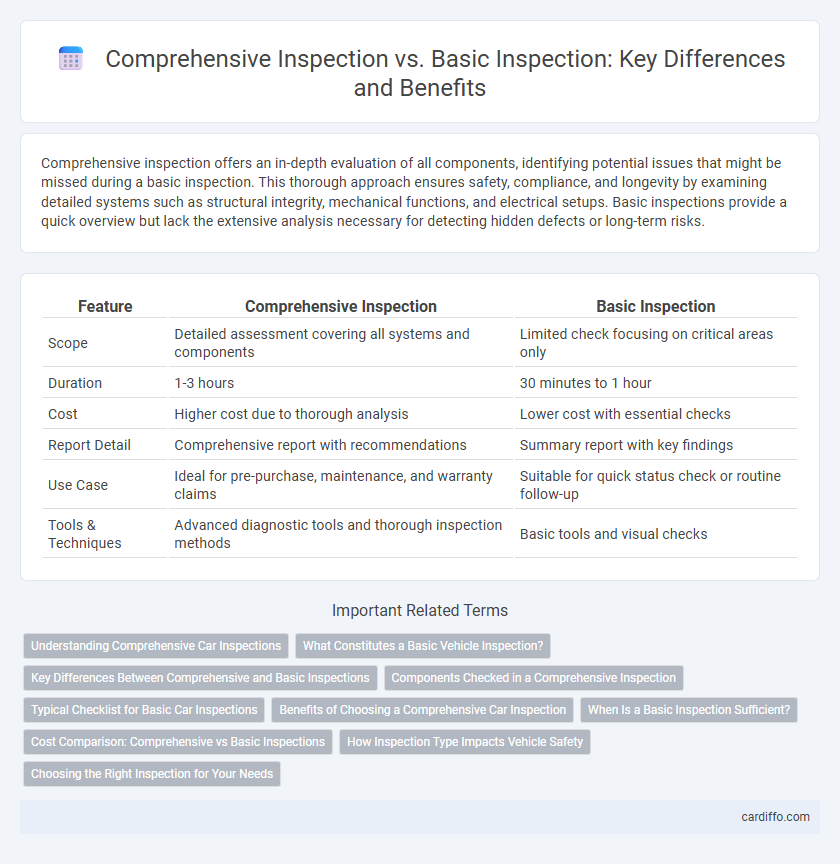Comprehensive inspection offers an in-depth evaluation of all components, identifying potential issues that might be missed during a basic inspection. This thorough approach ensures safety, compliance, and longevity by examining detailed systems such as structural integrity, mechanical functions, and electrical setups. Basic inspections provide a quick overview but lack the extensive analysis necessary for detecting hidden defects or long-term risks.
Table of Comparison
| Feature | Comprehensive Inspection | Basic Inspection |
|---|---|---|
| Scope | Detailed assessment covering all systems and components | Limited check focusing on critical areas only |
| Duration | 1-3 hours | 30 minutes to 1 hour |
| Cost | Higher cost due to thorough analysis | Lower cost with essential checks |
| Report Detail | Comprehensive report with recommendations | Summary report with key findings |
| Use Case | Ideal for pre-purchase, maintenance, and warranty claims | Suitable for quick status check or routine follow-up |
| Tools & Techniques | Advanced diagnostic tools and thorough inspection methods | Basic tools and visual checks |
Understanding Comprehensive Car Inspections
Comprehensive car inspections involve a detailed evaluation of a vehicle's mechanical, electrical, and safety systems, exceeding the scope of basic inspections that primarily focus on essential functions like brakes and lights. These thorough inspections include diagnostic scans, fluid analysis, and structural assessments to detect potential issues that may not be immediately visible. Understanding comprehensive inspections helps car owners maintain vehicle reliability, enhance safety, and prevent costly repairs by identifying problems early.
What Constitutes a Basic Vehicle Inspection?
A basic vehicle inspection typically includes evaluating essential safety components such as brakes, tires, lights, and windshield wipers to ensure the vehicle meets minimum safety standards. It involves checking fluid levels, tire pressure, and the condition of belts and hoses but does not extend to in-depth diagnostics or detailed engine assessments. This type of inspection is designed to quickly identify obvious issues that could affect the vehicle's safety and legal roadworthiness.
Key Differences Between Comprehensive and Basic Inspections
Comprehensive inspections involve a thorough evaluation of all system components, including detailed assessments of structural integrity, mechanical functionality, and safety compliance, while basic inspections primarily focus on surface-level checks and essential operational functions. Key differences include the depth of analysis, with comprehensive inspections utilizing advanced diagnostic tools and extensive testing procedures, whereas basic inspections rely on visual inspections and simple performance verifications. Comprehensive inspections are ideal for identifying hidden defects and long-term risks, whereas basic inspections serve as quick assessments for immediate condition status.
Components Checked in a Comprehensive Inspection
A comprehensive inspection examines a wide range of components including structural elements, mechanical systems, electrical wiring, plumbing, HVAC units, and safety features, ensuring an in-depth assessment of the property's condition. It covers both visible and accessible areas, identifying potential issues that a basic inspection might overlook, such as hidden water damage, faulty wiring, or foundation problems. This thorough evaluation provides a detailed report facilitating informed decision-making for buyers, sellers, or maintenance planning.
Typical Checklist for Basic Car Inspections
Basic car inspections typically include a checklist focusing on essential components such as tire condition, brake functionality, fluid levels, lights, and windshield wipers to ensure fundamental vehicle safety and operation. Comprehensive inspections extend beyond these basics by assessing engine health, transmission performance, suspension systems, battery status, and exhaust emissions, providing a thorough evaluation of overall vehicle condition. Understanding the typical checklist for basic inspections helps prioritize safety-critical maintenance while comprehensive inspections detect potential issues that might affect vehicle longevity and performance.
Benefits of Choosing a Comprehensive Car Inspection
A comprehensive car inspection uncovers hidden mechanical issues and potential safety hazards that a basic inspection may overlook, ensuring thorough vehicle assessment. This detailed evaluation enhances buyer confidence, supports informed decision-making, and can prevent costly repairs by identifying problems early. Choosing a comprehensive inspection ultimately improves overall vehicle reliability, safety, and long-term value.
When Is a Basic Inspection Sufficient?
A basic inspection is sufficient when assessing routine maintenance needs, identifying obvious defects, or ensuring compliance with simple safety standards. It covers key components like structural integrity, electrical systems, and plumbing but may not detect deeper issues requiring specialized expertise. For high-value properties or when significant concerns arise, a comprehensive inspection provides a thorough evaluation to prevent costly repairs and ensure long-term safety.
Cost Comparison: Comprehensive vs Basic Inspections
Comprehensive inspections typically cost two to three times more than basic inspections due to the in-depth analysis and specialized equipment involved. While basic inspections cover general structural and safety aspects, comprehensive inspections include detailed evaluations of electrical systems, plumbing, HVAC, and potential environmental hazards. Investing in a comprehensive inspection can prevent costly repairs by identifying issues early, outweighing the higher upfront expense compared to basic inspections.
How Inspection Type Impacts Vehicle Safety
Comprehensive inspections evaluate all vehicle systems including brakes, suspension, lights, and emissions, ensuring potential safety hazards are identified and addressed before they lead to accidents. Basic inspections focus primarily on essential components like lights, horn, and tires, which may overlook critical issues such as engine performance or structural integrity. The choice between comprehensive and basic inspection significantly impacts vehicle safety by determining the extent of risk factors detected and mitigated during the evaluation process.
Choosing the Right Inspection for Your Needs
Comprehensive inspection covers all systems and components in detail, offering a thorough evaluation ideal for high-value assets or pre-purchase decisions. Basic inspection focuses on essential elements, providing a quicker, cost-effective overview suitable for routine maintenance or minor concerns. Selecting the right inspection depends on the scope of assessment required, budget constraints, and the specific goals of the inspection process.
Comprehensive inspection vs basic inspection Infographic

 cardiffo.com
cardiffo.com